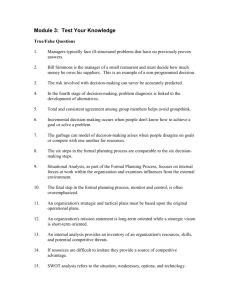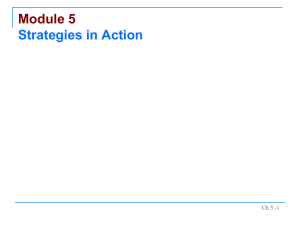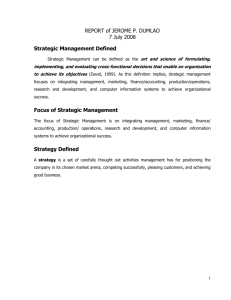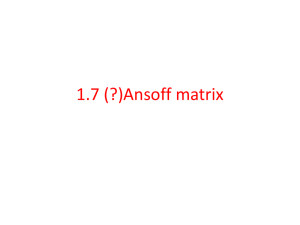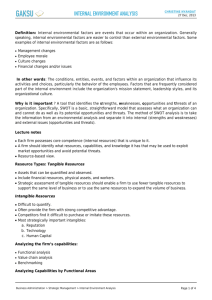Ch 8 Types of Strategy
advertisement
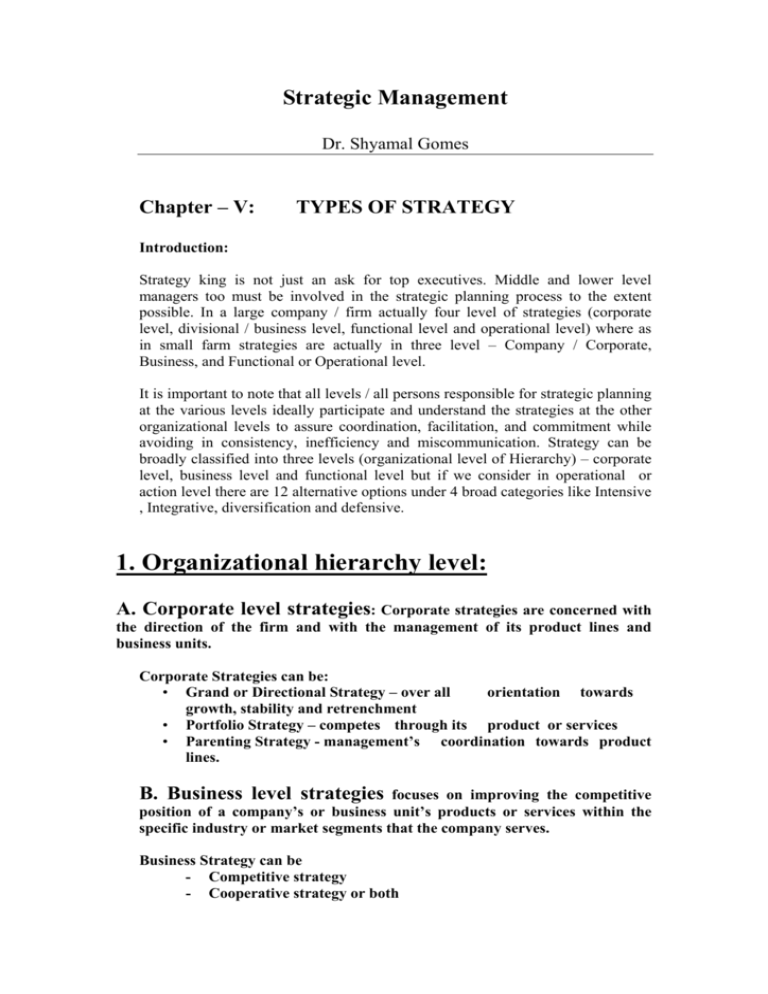
Strategic Management Dr. Shyamal Gomes Chapter – V: TYPES OF STRATEGY Introduction: Strategy king is not just an ask for top executives. Middle and lower level managers too must be involved in the strategic planning process to the extent possible. In a large company / firm actually four level of strategies (corporate level, divisional / business level, functional level and operational level) where as in small farm strategies are actually in three level – Company / Corporate, Business, and Functional or Operational level. It is important to note that all levels / all persons responsible for strategic planning at the various levels ideally participate and understand the strategies at the other organizational levels to assure coordination, facilitation, and commitment while avoiding in consistency, inefficiency and miscommunication. Strategy can be broadly classified into three levels (organizational level of Hierarchy) – corporate level, business level and functional level but if we consider in operational or action level there are 12 alternative options under 4 broad categories like Intensive , Integrative, diversification and defensive. 1. Organizational hierarchy level: A. Corporate level strategies: Corporate strategies are concerned with the direction of the firm and with the management of its product lines and business units. Corporate Strategies can be: • Grand or Directional Strategy – over all orientation towards growth, stability and retrenchment • Portfolio Strategy – competes through its product or services • Parenting Strategy - management’s coordination towards product lines. B. Business level strategies focuses on improving the competitive position of a company’s or business unit’s products or services within the specific industry or market segments that the company serves. Business Strategy can be - Competitive strategy - Cooperative strategy or both Competitive Strategy: Battling against all competitors for competitive advantage, raises two questions: 1. Should the firm compete on the basis of low cost or should the business differentiate it products or services? 2. Should the firm compete head to head with major competitors for profitable segment of the market? Lower cost strategy is the ability to provide design produce and market a comparable product more efficiently than its competitors. Differentiation strategy is the ability to provide unique or superior value to the buyer in terms of quality and after sales services Michael Porter proposes lower cost and differentiation strategy as generic competitive strategy because they can be pursued by any type or size of business. Cooperative Strategy: When the business units or firm working with one or more competitors to gain advantages against other competitors called cooperative strategy or strategic alliance. Strategic alliance is nothing but mutual benefits and broadly it is JV. C. Functional level Strategy: Functional Strategy is the approach a functional area takes to achieve corporate and business unit objectives and strategies by maximizing resources productivity. It is concentrate with developing and nurturing a distinctive competence to provide a company or business unit with a competitive advantages. The functional areas are: • Operational management areas- deals with product or production whether buy or make? While making any strategy operational group concentrate with 4 Key Factors: Compatibility, Configuration, Coordination and Control • Marketing management areas - deals with pricing, selling, distributing products, marketing mix, brand equity, product positioning etc. • HRM areas - deals with recruitment, staffing, organizational structure, performance appraisal, compensation plan etc. • Financial management areas - Deals with capital structure, Fund flow an cash flow management 2. Action or operational level: However, there are 4 alternative broad strategies like Integration strategy, Intensive strategy, Diversification strategy and Defensive strategy. An enterprise could peruse these strategies categorizing into 12 alternative options: forward integration, backward integration, horizontal integration, market penetration, market development, product development, concentric diversification, conglomerate diversification, horizontal diversification, retrenchment, divestiture, and liquidation. Sl Types of Alternative Related to Actions Comes Strategy 1. Forward Integration Integration / vertical Integration strategy 2. 3. 4. Backward Integration Horizontal Integration Market penetration 5. Market development 6. Product development 7. Concentric Diversification 8. Conglomerate diversification 9. Horizontal diversification 10. Retrenchment 11. Divestiture 12. Liquidation Control over Distributors/ Retailers Control over Suppliers Control over Competitors Increased market share for present products Enter in new area with present product Increase sales or adding new area Adding new but unrelated product Adding new but related product Adding new but unrelated product for present customers Regrouping through Assets and cost reduction Selling a division or part of the organization Selling all company’s assets / parts for their tangible worth. under Intensive Strategy Diversification Strategy Defensive Strategy Integration Strategies: These strategies are implemented when he organization is in no mood situation to diversify but loosing a foothold in the market. Forward integration, backward integration, and horizontal integration are some times collectively referred to as vertical integration strategies. Forward Integration: Forward integration involves gaining ownership or increased control over distributors or retailers. Increasing numbers of manufacturers (suppliers) today are perusing of forward integration strategy by establishing the web site to sell products directly to the consumers. This strategy is causing turmoil in some industries. Six guiding principles for when forward integration may be an effective strategy for the company and they are: • • • • • • When the resent distributors are expensive, or unreliable, or incapable of meeting the firm’s distribution needs When the availability of quality distributors is too limited as to offer a competitive advantages When an organization competes in an industry that is growing and is expected to continue to grow markedly: this is a factor because forward integration reduces an organization‘s ability to diversify if its basic industry falters. When an organization has both the capital and human resources needed to manage the new business of distributing its own products. When the advantages of stable production are particularly high: this is a consideration because an organization can increase the predictability of the demand for its output through forward integration. When present distributors or retailers have high profit margins: this situation suggests that a company profitably could distribute its own products and price them more competitively by integrating forward. Backward Integration: Both manufactures and retailers purchase needed materials from suppliers. Backward integration is a strategy of seeking ownership or increased control of a firm’s suppliers. This strategy can be especially appropriate when a firm’s current suppliers are unable, too costly or cannot meet the firm’s needs. Seven guidelines for when backward integration may be an especially effective strategy are: • When the resent distributors are expensive, or unreliable, or incapable of meeting the firm’s needs for parts, components, assembles or raw materials • When the numbers of suppliers is small and the number of competitors is large. • When an organization competes in an industry that is growing rapidly: this is a factor because integrative – type strategies (forward – backward – horizontal) reduce an organizations ability to diversify in a declining industry. • When an organization has both capital and human resources to manage the new business of supplying its own raw materials. • When the advantages of stable prices are particularly important: this is a factor because an organization can stabilize the cost of its raw materials and the associated price of its products through backward integration. • When present supplies have high profit margins. • When an organization needs to acquire a needed resources quickly. Horizontal Integration: Horizontal Integration refers to a strategy of seeking ownership of or increased control over firm’s competitions. One of the most significant trends in strategic management today is the increased use of horizontal integration as a growth strategy. Managers, acquisitions, and takeovers among competitors allow for increased economics of scale and enhanced transfer of resources and competencies. Five guidelines for when horizontal integration may be an especially effective strategy for the company and they are: • • • • • When an organization can gain monopolistic characteristics in a particular area or region without being challenged by the federal government for “tending substantially” to reduce competitions. When an organization competes in a growing industry. When increased economics of scale provide major competitive advantages. When an organization has both the capital and human talent needed to successfully manage an expanded organizations. When competitors are faltering due to a lack of managerial expertise or a need for particular resources that an organization possesses. Note that horizontal integration would not be appropriate if competitors are doing poorly, because in that case overall industry sales are declining. INTENSIVE STRATEGIES: Market penetration, market development and product development are sometimes referred to as intensive strategies because they require intensive efforts if a firm’s competitive position with existing products is to improve. Market Penetration: A market penetration strategy seeks to increase market share for resent products or services in resent markets through greater marketing efforts. This strategy is widely used alone and in combination with other strategies. Market penetration includes increasing the number of sales persons, increasing advertising expenditures, offering extensive sales promotion items, or increasing publicity efforts. Five guiding principles for when market penetration may be an especially effective strategy for the company and they are: • • • • • When current markets are not saturated with a particular product or services When the usages rate of present customers could be increased significantly When the market shares of major competitors have been declining while total industry sales have been increasing. When the correlation between dollar sales and dollar marketing expenditure historically has been high. When increased economics of scale provide major competitive advantages. Market Development: Market development involves introducing present products or services into new geographic areas. Like, McDonald’s had plan to open 100 new stores in China in 2004 and another 100 in China in 2005. By mid 2003, Mc Donald’s had 566 restaurants in 94 cities in China, representing the company’s seventh largest market. Presently McDonald serves about 2-3 million customer everyday in china and plans to boost the numbers. Six guiding principles for when market development may be an effective strategy for the company and they are: • When new channel of distribution are available that are reliable, inexpensive and of good quality. • When an organization is very successful at what it does. • When new untapped or unstructured markets are exists • When an organization has the needed capital and human resources to manage the extended operations. • When an organization has excess production capacity. • When an organization’s basic industry is becoming rapidly global in scope. Product Development: Product development is a strategy that seeks increased sales by improving or modifying present products or services. Product development usually entails large research and development expenditures. Fast food chains from Arby’s to McDonald’s are pursuing product development, testing gourmet – like sandwiches – because customers increasingly are willing to pay more for fast food crafted with quality ingredients. People more and more want food that not only tests good but those they can feel good about eating. Five guiding principles for when product development may be an effective strategy to pursue for the company and they are: • • • • • When an organization has successful products that are in maturity stage of the product life cycle. When an organization competes in an industry that is characterized by rapid technological developments. When major competitors offer better – quality products at comparable rate / prices. When an organization competes in a high growth industry. When an organization has especially strong research and development capabilities. Diversification Strategies: When a company’s current product lines do not have much growth potential, management may decide to diversify in business called diversification strategy. There are three general types of diversification strategies: 1. Concentric 2. Horizontal 3. Conglomerate Basic understanding of these strategies: Concentric Adding new, but related, products or services is widely called concentric diversification Concentric diversification always search the Synergy, the concept that two businesses will generate more profits to gather than they could separately Horizontal Adding new unrelated products or services for present customers called horizontal diversification This strategy is not as risky as conglomerate diversification because a firm already should be familiar with its present customers Conglomerate Adding new unrelated products or services is called conglomerate diversification Diversifying into an industry unrelated to its current one. Rather than maintaining a common thread throughout their organization, managers who adopt this strategy are concerned primarily with financial consideration of cash flows or risk reductions. When these diversifications are applicable for an Industry or company as an effective strategy • When an organization competes in a no • When revenues derived from an organization’s • When organization the capital an has and • • • growth or a slow – growth industry Has a strong management team Products are currently in the declining stage of the product’s life cycle. New, but related product could be offered at highly competitive price and enhance the sales Dell computer is pursuing concentric diversification by manufacturing and marketing consumer electrical products like flat – panel televisions and MP3 players. Also dell has recently opened an online music downloading store. Why: the company management sees that the personal computer business becoming more aligned with the entertainment business because both are coming more and more digital current products or services would increase significantly by adding the new, unrelated products • When an org. competes in a high competitive environment • When an org. present channels of distribution can be used to market the new products to current customers Many Hospitals previously had only cafeterias, gift shops, flower shop, and may be a pharmacy, but the movement into malls by offering banks, bookstores, coffee shops, restaurants, drugstores and other retail stores is aimed at improving the ambiance for patients and their visitors. The New University Pointe Hosptal in West Chester, Ohio, has 75,000 square feet of retail space. The CEO says, “Unless we diversify our revenue, we won’t be able fulfill our mission of providing health care. We want our hospital to be a place that people want to go to”. Defensive Strategies: managerial talent needed to compete successfully in a new industry • When an organization has the opportunity to purchase an unrelated business that is an attractive investment opportunity. • When existing markets for an organization’s present products are saturated. The coffee shop co. Starbucks entered the prepaid card and credit card business in late 2003 by developing its Duetto card. This card is one of the first dual prepaid / credit cards. This strategy of creating the Duetto card will act as a lure, Starbucks excepts, to keep consumers coming back into its shops When a company’s current product lines faces lots of problems in growth potential, management may decide to take defense in business called defensive strategy. There are three general types of defensive strategies: 1. Retrenchment 2. Divestiture 3. Liquidation Retrenchment Divestiture Liquidation Retrenchment occurs when an Selling a division or part Selling all f a company’s organization regroups through of an organization is called assets, in parts, for their cost and asset reduction to divestiture. Divestiture tangible worth s called reverse declining sales and often is used to raise Liquidation. It is recognition of profits. Sometimes called a capital for further strategic defeat and consequently can be turnaround or re-organizational acquisitions or emotionally difficulty strategy. strategy, it is designed to investments. It can be a However, it may be better to fortify an organization’s basic part of an overall cease operating than to distinctive competence. retrenchment strategy to continue losing large sums of rid an organization of money. business that are unprofitable, that requires too much capital, or that do not fit well with the fir’s other activities. When these defensive strategies are applicable for an Industry or company as an effective strategy • • • • When an org. has a clearly distinctive competence but to fails to meet its objectives and goals consistently over time When an organization is the weaker competitors in a given industry. When an org. has failed to capitalize the external opportunities, minimize the threats, take advantage of internal strength and overcome the weaknesses. When the org. has grown so large so quickly that major internal reorganization is needed • • • • When an org. has pursued a retrenchment strategy and failed to accomplish needed improvement. When a division is responsible for an organization‘s overall poor performance When a large no. of cash needed quickly and cannot be obtained reasonably from other sources When Government antitrust action threatens an organization • • • When an org. has pursued both a retrenchment strategy and a divestiture strategy, and neither has been successful. When an organization’s only alternative is bankruptcy, liquidation represents an orderly and planned means of obtaining the greatest possible cash for an organization’s assets. When the stockholders of a firm can minimize their losses by selling the organization’s assets Finally, to some extent strategic choice shapes and even limits the goals a company can reasonably pursue. The logically viable strategy emerges where the three logical elements overlap. Where all three circles overlap, the differing requirements of intent and assessment are most fully met. Where any two circles overlap are areas where feasible options may exist. They may not be aligned to strategic intent, or if they are aligned are not found feasible. Choices of what not to do may sometimes be as important as choosing what to do.

